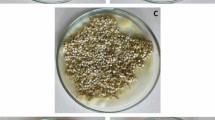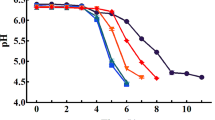Abstract
Amaranth (Amaranthus spp.) grains have become essential for human health and nutrition; due to the presence of bioactive compounds that have shown some biological activities. This study aimed to evaluate the effect of germination, enzymatic hydrolysis, and its combination on the phytochemical compounds and antioxidant activity in Mexican amaranth. Germinated amaranth flours (GAF) exhibited increases in the concentrations of soluble protein (SP), total phenolic content (TPC), total flavonoid content (TFC), total anthocyanin content (TAC) and antioxidant activity (AOX) by 35.7, 17.2, 163.0, 1472.2, and 54.3%, respectively, compared with ungerminated amaranth flours (UAF). In SDS-PAGE, both hydrolysates of UAF and GAF exhibited low molecular weight bands (< 10 kDa). The hydrolysates of UAFH and GAFH had the highest degree of hydrolysis at 205 min of sequential hydrolysis (pepsin with pancreatin) time with 73.4 and 60.3%, respectively. Both hydrolysates obtained from GAF and UAF released significantly SP, TPC, TFC after sequential enzymatic hydrolysis (up 205 min), which led to a remarkable improvement of AOX when compared to nonhydrolyzed amaranth samples. The UAFH and GAFH had the best AOX at 270 min of enzymatic hydrolysis with 983.1 and 1304.9 μmol TE/mg SP, respectively. Hence, the combination of germination and enzymatic hydrolysis could be used to produce functional ingredients for food product development.


Similar content being viewed by others
Abbreviations
- GAF:
-
Germinated amaranth flour
- UAF:
-
Non-germinated amaranth flour
- GAFH :
-
Germinated amaranth flour hydrolysate
- UAFH:
-
Non-germinated amaranth flour hydrolysate
- DH:
-
Degree of hydrolysis
- AOX :
-
Antioxidant activity
References
Montoya-Rodríguez A, Milán-Carrillo J, Dia VP, Reyes-Moreno C, González de Mejía E (2014) Pepsin-pancreatin protein hydrolysates from extruded amaranth inhibit markers of atherosclerosis in LPS-induced THP-1 macrophages-like human cells by reducing expression of proteins in LOX-1 signaling pathway. Proteome Sci 12:30. https://doi.org/10.1186/1477-5956-12-30
Tang Y, Tsao R (2017) Phytochemicals in quinoa and amaranth grains and their antioxidant, anti-inflammatory, and potential health beneficial effects: a review. Mol Nutr Food Res 61:7. https://doi.org/10.1002/mnfr.201600767
Montoya-Rodríguez A, Gómez-Favela MA, Reyes-Moreno C et al (2015) Identification of bioactive peptide sequences from amaranth (Amaranthus hypochondriacus) seed proteins and their potential role in the prevention of chronic diseases. Compr Rev Food Science F 14:139–158. https://doi.org/10.1111/1541-4337.12125
Orsini Delgado M, Galleano M, Añón M, Tironi V (2015) Amaranth peptides from gastrointestinal digestion: antioxidant activity against physiological reactive species. Plant Foods Hum Nutr 70:27–34. https://doi.org/10.1007/s11130-014-0457-2
Milán-Carrillo J, Montoya-Rodríguez A, Reyes-Moreno C (2012) High-antioxidant capacity beverages based on extruded and roasted amaranth (Amaranthus hypochondriacus) flour. In: Tunick MH, González de Mejía E (eds) Hispanic foods: chemistry and bioactive compounds, vol 1109, 1st edn. American Chemical Society, Washington, D.C., pp 199–216. https://doi.org/10.1021/bk-2012-1109.ch013
Perales-Sánchez JXK, Reyes-Moreno C, Gómez-Favela MA, Milán-Carrillo J, Cuevas-Rodríguez EO, Valdez-Ortiz A, Gutiérrez-Dorado R (2014) Increasing the antioxidant activity, total phenolic and flavonoid contents by optimizing the germination conditions of Amaranth seeds. Plant Foods Hum Nutr 69:196–202. https://doi.org/10.1007/s11130-014-0430-0
Montoya-Rodríguez A, González de Mejía EG, Dia VP et al (2014) Extrusion improved the anti-inflammatory effect of amaranth (Amaranthus hypochondriacus) hydrolysates in LPS-induced human THP-1 macrophage-like and mouse RAW 264.7 macrophages by preventing activation of NF-κB signaling. Mol Nutr Food Res 58:1028–1041. https://doi.org/10.1002/mnfr.201300764
Orsini Delgado MC, Tironi VA, Añón MC (2011) Antioxidant activity of amaranth protein or their hydrolysates under simulated gastrointestinal digestion. LWT-Food Sci Technol 44:1752–1760. https://doi.org/10.1007/s11130-014-0457-2
López-Barrios L, Antunes-Ricardo M, Gutiérrez-Uribe JA (2016) Changes in antioxidant and antiinflammatory activity of black bean (Phaseolus vulgaris L.) protein isolates due to germination and enzymatic digestion. Food Chem 203:417–424. https://doi.org/10.1016/j.foodchem.2016.02.048
Nielsen PM, Petersen D, Dambmann C (2001) Improved method for determining food protein degree of hydrolysis. J Food Sci 66:642–646. https://doi.org/10.1111/j.1365-2621.2001.tb04614.x
Singleton VL, Orthofer R, Lamuela-Raventos RM (1999) Analysis of total phenols and other oxidation substrates and antioxidants by means of folin-ciocalteu reagent. Methods Enzymol 299:152–178. https://doi.org/10.1016/S0076-6879(99)99017-1
Heimler D, Vignolini P, Dini MG, Romani A (2005) Rapid tests to assess the antioxidant activity of Phaseolus vulgaris L. dry beans. J Agric Food Chem 53:3053–3056. https://doi.org/10.1021/jf049001r
Abdel-Aal ESM, Hucl P (1999) A rapid method for quantifying total anthocyanins in blue aleurone and purple pericarp wheats. Cereal Chem 76:350–354. https://doi.org/10.1094/CCHEM.1999.76.3.350
Broadhurst RB, Jones WT (1978) Analysis of condensed tannins using acidified vanillin. J Sci Food Agric 29:788–794. https://doi.org/10.1002/jsfa.2740290908
Ou B, Hampsch-Woodill M, Prior RL (2001) Development and validation of an improved oxygen radical absorbance capacity assay using fluorescein as the fluorescent probe. J Agric Food Chem 49:4619–4626. https://doi.org/10.1021/jf010586o
Vernaza MG, Dia VP, Gonzalez de Mejia E et al (2012) Antioxidant and antiinflammatory properties of germinated and hydrolysed Brazilian soybean flours. Food Chem 134:2217–2225. https://doi.org/10.1016/j.foodchem.2012.04.037
De Souza RT, Hernandez LMR, Chang YK et al (2014) Impact of germination and enzymatic hydrolysis of cowpea bean (Vigna unguiculata) on the generation of peptides capable of inhibiting dipeptidyl peptidase IV. Food Res Int 64:799–809. https://doi.org/10.1016/j.foodres.2014.08.016
Zhang G, Xu Z, Gao Y, Huang X, Zou Y, Yang T (2015) Effects of germination on the nutritional properties, phenolic profiles, and antioxidant activities of buckwheat. J Food Sci 80:H1111–HH1119. https://doi.org/10.1111/1750-3841.12830
Guardado-Félix D, Serna-Saldivar SO, Cuevas-Rodríguez EO, Jacobo-Velázquez DA, Gutiérrez-Uribe JA (2017) Effect of sodium selenite on isoflavonoid contents and antioxidant capacity of chickpea (Cicer arietinum L.) sprouts. Food Chem 226:69–74. https://doi.org/10.1016/j.foodchem.2017.01.046
Olawoye BT, Gbadamosi SO (2017) Effect of different treatments on in vitro protein digestibility, antinutrients, antioxidant properties and mineral composition of Amaranthus viridis seed. Cogent Food Agric 3:1296402. https://doi.org/10.1080/23311932.2017.1296402
Kumari S, Krishnan V, Sachdev A (2015) Impact of soaking and germination durations on antioxidants and anti-nutrients of black and yellow soybean (Glycine max L.) varieties. J Plant Biochem Biotechnol 24:355–358. https://doi.org/10.1007/s13562-014-0282-6
Acosta-Estrada BA, Gutiérrez-Uribe JA, Serna-Saldívar SO (2014) Bound phenolics in foods, a review. Food Chem 152:46–55. https://doi.org/10.1016/j.foodchem.2013.11.093
Tironi VA, Añón MC (2010) Amaranth proteins as a source of antioxidant peptides: effect of proteolysis. Food Res Int 43:315–322. https://doi.org/10.1016/j.foodres.2009.10.001
Silva-Sánchez C, Barba de la Rosa APB, León-Galván MF, De Lumen BO, De León-Rodríguez A, De Mejía-González E (2008) Bioactive peptides in Amaranth (Amaranthus hypochondriacus) seed. J Agric Food Chem 56:1233–1240. https://doi.org/10.1021/jf072911z
Aphalo P, Martínez EN, Añón MC (2015) Amaranth sprouts: a potential health promoting and nutritive natural food. Int J Food Prop 18:2688–2698. https://doi.org/10.1080/10942912.2015.1004585
Jamdar SN, Rajalakshmi V, Pednekar MD, Juan F, Yardi V, Sharma A (2010) Influence of degree of hydrolysis on functional properties, antioxidant activity and ACE inhibitory activity of peanut protein hydrolysate. Food Chem 121:178–184. https://doi.org/10.1016/j.foodchem.2009.12.027
Pazinatto C, Malta LG, Pastore GM et al (2013) Antioxidant capacity of amaranth products: effects of thermal and enzymatic treatments. Food Sci Technol 33:485–493. https://doi.org/10.1590/S0101-20612013005000076
Pellegrini M, Lucas-Gonzalez R, Fernandez-Lopez J et al (2017) Bioaccessibility of polyphenolic of six quinoa seeds during in vitro gastrointestinal digestion. J Funct Foods 38:77–88. https://doi.org/10.1016/j.jff.2017.08.042
Soriano Sancho RA, Pavan V, Pastore GM (2015) Effect of in vitro digestion on bioactive compounds and antioxidant activity of common bean seed coats. Food Res Int 76:74–78. https://doi.org/10.1016/j.foodres.2014.11.042
Guan H, Diao X, Jiang F, Han J, Kong B (2018) The enzymatic hydrolysis of soy protein isolate by Corolase PP under high hydrostatic pressure and its effect on bioactivity and characteristics of hydrolysates. Food Chem 245:89–96. https://doi.org/10.1016/j.foodchem.2017.08.081
Author information
Authors and Affiliations
Corresponding author
Ethics declarations
Conflict of Interest
There are no conflicts of interest to declare.
Additional information
Publisher’s Note
Springer Nature remains neutral with regard to jurisdictional claims in published maps and institutional affiliations.
Rights and permissions
About this article
Cite this article
Sandoval-Sicairos, E.S., Domínguez-Rodríguez, M., Montoya-Rodríguez, A. et al. Phytochemical Compounds and Antioxidant Activity Modified by Germination and Hydrolysis in Mexican Amaranth. Plant Foods Hum Nutr 75, 192–199 (2020). https://doi.org/10.1007/s11130-020-00798-z
Published:
Issue Date:
DOI: https://doi.org/10.1007/s11130-020-00798-z




